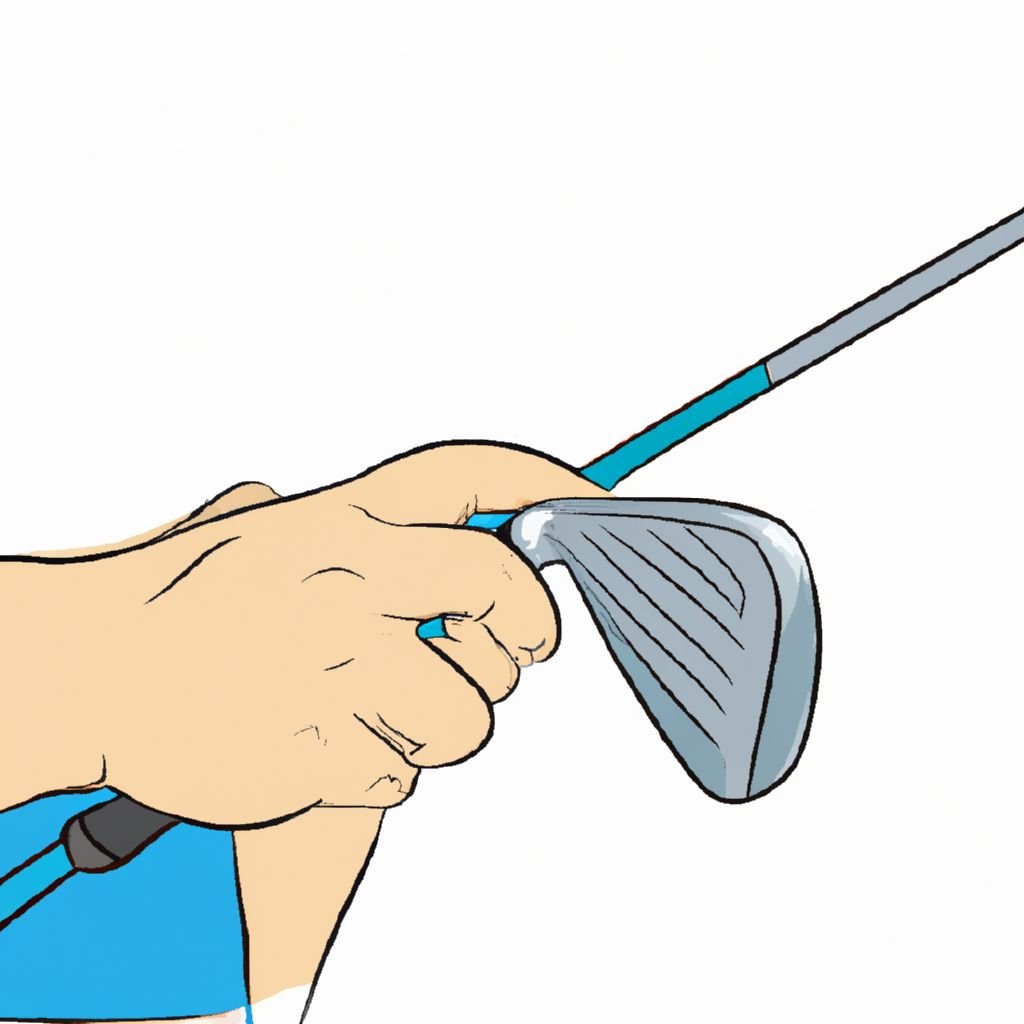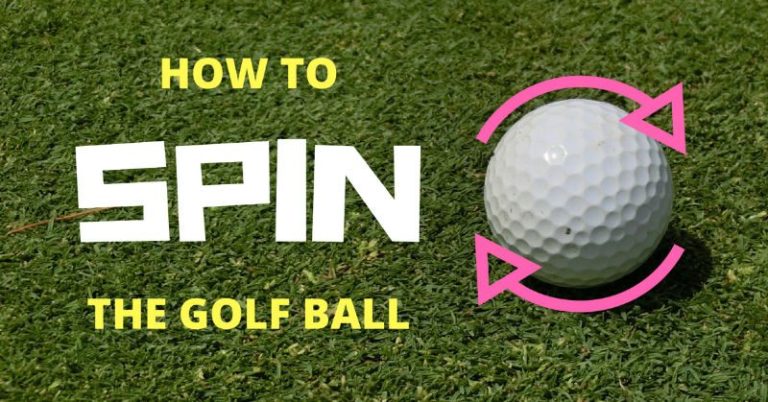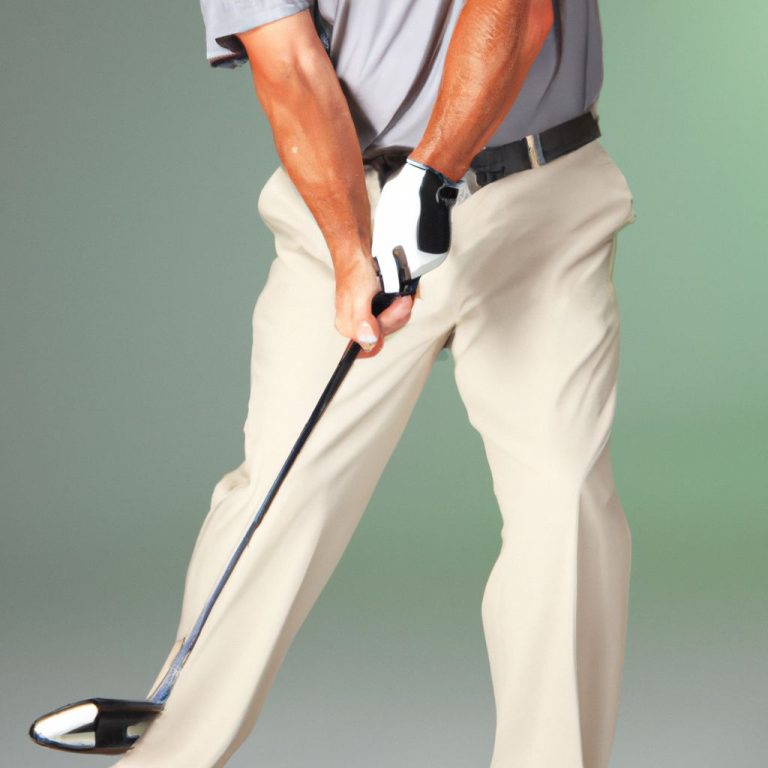Mastering the Grip: How to Hold a Golf Club Right-Handed for Maximum Performance
Key Takeaway:
- A proper grip in golf is crucial for consistent and accurate shots.
- There are different types of grips, such as the 10 finger grip, overlapping grip, and interlocking grip, each with its own advantages and suitability for different players.
- Factors to consider in choosing a grip include comfort, feel, and individual hand size, with personalized advice and feedback from professionals being beneficial for grip improvement.
- The grip has a significant impact on club face control and swing path, affecting the desired ball flight, so it’s important to understand how grip adjustments can influence the outcome of shots.
- Maintaining proper grip pressure involves finding the right balance between firmness and relaxation, avoiding extremes of loose and tight grip pressure.
Overview of the importance of a proper grip in golf
A proper grip in golf is essential for consistent and accurate shots. In this overview, we’ll discuss why having the right grip is crucial and the impact it can have on controlling the club and determining the outcome of your shots. So, let’s dive into the importance of a proper grip and how it can significantly enhance your golf game.

Importance of a proper grip for consistent and accurate shots
Golfers must grasp the importance of a proper grip. It impacts the club and thus affects the outcome of each shot. There are different types of grips, such as 10-finger, overlapping, and interlocking. Each has its benefits and drawbacks.
Hand size and personal preference should be taken into account when selecting a grip. Comfort and feel matter too, for they boost confidence and shot execution. Players should be aware that grip adjustments can seriously affect ball flight.
Maintaining the correct gripping pressure is also essential. Finding a balance between firmness and relaxation ensures optimal control. Those looking to improve their grip should seek professional guidance through private lessons or group classes. These sessions provide tailored advice and feedback, improving technique and performance.
In conclusion, choosing the right grip can decide whether the ball goes on the green or in the ground – so choose wisely!
Impact of grip on club control and shot outcome
Grip is key in golf – it affects control and shot outcome. The way a golfer holds the club has an impact on their ability to hit accurate shots. Different types of grips like the 10 finger, overlapping and interlocking have their own advantages and disadvantages, depending on hand size and preference.

The 10 finger grip involves all 10 fingers on the grip. It’s great for beginners or players with weaker hands, but may lack the finesse for advanced shots.
The overlapping grip, or Vardon grip, is common for right-handed golfers. The trailing hand pinky goes on top of the lead hand index. This gives increased control and stability, thanks to better hand connection to the club.
The interlocking grip is suitable for those with medium to smaller hands. The trailing hand pinky intertwines with the lead hand index. This creates a secure connection between hands and improves control.
To find the best grip, consider hand size and comfort. It must feel natural and allow for proper control during the swing.
Grip has an impact on ball flight characteristics. Changing the grip can help achieve a desired trajectory by influencing hand control.
Grip pressure is essential for consistent performance. The right balance between firmness and relaxation is vital to maintain control without sacrificing fluidity or flexibility.
Look for professional guidance to find the best grip. Private lessons or group classes provide personalized advice and feedback.
Gripping the golf club is like finding the right partner – it’s all about compatibility.
Explanation of different types of grips
Discover the secrets of mastering your golf grip with a breakdown of the different types of grips. Explore the advantages and disadvantages of the 10 finger grip, the benefits for right-handed golfers with the overlapping grip, and the suitability of the interlocking grip for players with medium to smaller hands. Improve your game by finding the right grip that suits your style and enhances your performance on the golf course.

The 10 finger grip and its advantages and disadvantages
The 10 finger grip, also known as the baseball grip, is a popular style of gripping the golf club. All ten fingers are placed on the handle, without overlapping or interlocking of the hands.
This grip has several advantages. It provides a stronger connection between the hands and the club, leading to greater stability and improved swing speed. Additionally, it allows for better shot shaping due to more control over the clubface.
However, it also comes with some downsides. It can be difficult to maintain consistent hand placement throughout the swing, which can lead to inconsistency in shot direction. Furthermore, there is reduced hand unity and feel for the club.
Overall, the 10 finger grip has both pros and cons. Golfers should consider their individual preferences and abilities when choosing which grip works best for them.
The overlapping grip and its benefits for right-handed golfers
Right-handed golfers are known for their use of the overlapping grip – a style that offers multiple benefits. The little finger of the trailing hand is placed over the index finger of the lead hand, creating an interlocking connection. This grip ensures control and stability, resulting in improved accuracy and distance on shots.

Players can enjoy:
- Increased club control
- Improved shot outcome
- Better power transfer
- Increased comfort and feel
- Suitability for various hand sizes
The overlapping grip was popularized by Harry Vardon in the late 19th century and is still widely used today. It has become an integral part of golfing technique for many right-handed players seeking to elevate their skills. It’s an interlocking handshake that guarantees a firm hold – even for players with tiny hands!
The interlocking grip and its suitability for players with medium to smaller hands
The interlocking grip is an ideal technique for golfers with medium to smaller hands. It involves intertwining the pinky finger of the trailing hand and the index finger of the leading hand.
This grip provides many benefits, like:
- A more stable and secure connection between the hands and the club.
- Better control over the club, reducing the risk of it slipping.
- A more unified and synchronized motion throughout the swing, resulting in greater accuracy and consistency.
- A firm hold on the club without excessive tension or strain in their fingers and wrists.
- Enhanced comfort and feel.
The interlocking grip is perfect for golfers who have medium to smaller hands. It provides a secure connection, improved control, unified motion, and comfort and feel. They should try it out to see if it boosts their performance on the course.
Finding the best grip is like finding the right balance between a gentle handshake and a death grip!
Determining the best grip for individual players
Dive into the importance of finding the perfect grip in golf and discover how it can greatly impact your game. Explore the key factors to consider when choosing a grip, and learn why comfort and feel play a vital role in selecting the right one for you. Let’s uncover the secrets to a more effective and successful golf swing by finding the perfect grip that suits your individual playing style.
Factors to consider in choosing a grip
Hand size and shape are key when choosing a grip for golf. Every individual is unique, so finding a grip that works best for them is essential.
Grip preference matters too, like whether the player wants a firmer or looser grip.
Shot goals should also be taken into account. Different grips may affect club control, shot trajectory, and accuracy.
Level of experience and skill should be considered. Beginners need grips that are easy to use and consistent. Advanced players may prefer more options for fine-tuning.
Physical limitations should also factor in. Comfort and consistency are important for long-term use.
Seeking professional guidance can help find the right grip. An experienced golf instructor can offer personalized advice and feedback.
These factors can help each golfer find a grip that is both comfortable and in control. Don’t overlook the power of comfort and feel when choosing the perfect golf grip.
Importance of comfort and feel in selecting the right grip
Comfort and grip are essential when picking the right golf grip. The comfort you feel when gripping the club influences your precision and accuracy when swinging. A grip that feels natural and secure ensures control over the club and powerful shots.
Various grips are available, and it’s important to choose one that suits your individual needs. The 10 finger grip may provide stability, but not as much control or finesse. Overlapping, favored by right-handed golfers, promotes a stronger connection between their hands and better control when swinging.
Interlocking grip may be best for those with medium-sized or smaller hands. This grip style allows natural wrist movement and stability throughout the swing. When selecting a grip, consider hand size, flexibility, and preferences.
Remember, comfort and feel are important, but not more than shot outcome or club control. Find a balance between comfort and functionality. Professional guidance or classes can help select a grip that suits your playing style.
Understanding the impact of grip on club face and swing path
Understanding the impact of grip on the club face and swing path is crucial for golfers seeking to improve their game. In this section, we will explore how grip changes can influence ball flight and how making adjustments to the grip can help achieve the desired trajectory. By understanding the intricacies of the grip and its relationship to the swing, golfers can make informed decisions to optimize their performance on the course.
How grip changes affect ball flight
Grip changes have a major effect on the flight of a golf ball. By changing how a golfer holds the club, it can affect accuracy and trajectory of the shot.
- Modifying the grip alters the angle of the clubface when it hits the ball. A stronger grip (right-handed golfers turning hands more right) closes the clubface, creating a draw or hook. Whereas, a weaker grip with less rotation opens the clubface, causing a fade or slice.
- Grip can also alter swing plane and path. A neutral grip promotes a straight line swing, giving straighter shots. But, adjusting grip position can intentionally make fades or draws.
- Grip position impacts timing and control. With certain grip changes, golfers can control when and how much their hands release during the downswing, influencing shot shape and distance.
- Grip pressure is another important factor. Lighter pressure lets better clubhead speed and greater distance, but less control over direction. Excess pressure restrains wrist hinge, lessening power.
- Lastly, grip changes may impact how the ball is hit. Adjusting hand position or angle on the club can alter where on the clubface contact occurs. This leads to variations in spin rate, launch angle, and ball flight behaviour.
- Learning how different grip changes influence the ball flight helps golfers adjust their shots based on the situation.
Golfers ought to find the balance between trying different grips and keeping consistency. It is beneficial to get personalized guidance from experts, to find which grip adjustments fit the player’s skill level, body, and preferences.
Achieving desired ball flight through grip adjustments
Grip adjustments are key for getting the desired ball flight in golf. Changing the way you hold the club can really influence the ball’s trajectory to its target.
- Grip changes are essential for steering the ball and affecting its path.
- By making small alterations to the grip, golfers can alter the club face angle at impact, which will then affect the ball spin and flight.
- For instance, fixing the grip to be slightly stronger or weaker can correct a slice or hook.
- Also, changing the grip pressure can create different flight paths. A firmer grip could bring more control and a lower flight, while a looser grip will cause the ball to fly higher and further.
- It’s essential to learn how to make these grip adjustments with accuracy and consistency to get the best results on various courses.
Golfers must consider many elements when aiming for desired ball flight, for example their swing technique, individual preferences, and playing conditions. With the right grip adjustments, players have more control over their shots.
Though it’s important to practice and try different grips to find what works best, taking professional guidance can be very helpful.
Generally speaking, to get the desired ball flight through grip adjustments, golfers need to think about their technique, recognize personal tendencies, experiment with different grips, and get help from pros if needed. All this can lead to improved accuracy and control, helping to boost performance on the course.
Maintaining proper grip pressure
Maintaining a proper grip pressure is crucial for a successful golf swing. In this section, we’ll explore the delicate balance between firmness and relaxation in grip pressure. We’ll also discuss the importance of avoiding the extremes of a loose or tight grip, ensuring optimal control and accuracy in your golf shots. So, let’s dive in and discover the key techniques to enhance your grip pressure for a better golf game.
Finding the balance between firmness and relaxation in grip pressure
Grip is essential in golf for consistent and accurate shots. Players must find the balance between firmness and relaxation in grip pressure. Too much tension or too little will lead to poor results.
Practice different levels of grip pressure to find what works. It may vary from person to person due to hand size, strength, and swing style. Professional help is recommended to get personalized feedback and advice.
By finding the right balance of grip pressure, players can enhance their consistency and accuracy. It’s an important part of mastering the game and achieving desired ball flight patterns. So practice different grips and seek expert guidance. Don’t miss out on improving your game by neglecting grip pressure – find the perfect balance!
Avoiding the extremes of loose and tight grip pressure
Struggling with your grip? Don’t let your golf swing become a ‘grip’ing horror show! Achieve consistent and accurate shots by avoiding the extremes of loose and tight grip pressure. Here’s a 4-step guide to help:
- Evaluate your current grip pressure. Pay attention to how tight you hold the club and if there’s any tension in your hands.
- Experiment with different pressures. Vary the intensity while maintaining control. Gradually adjust until you find the right balance.
- Keep muscles relaxed. Loosen your grip slightly between shots to avoid tension.
- Seek feedback from professionals. They can evaluate your technique and give personalized advice.
Other factors to consider: hand size, strength, flexibility, and personal preferences. Plus, understand how grip pressure affects ball flight. Practice shot adjustments with different clubs and swing types.
For the perfect hold, get professional guidance!
Seeking professional guidance for finding the best grip
Seeking professional guidance for finding the best grip can greatly improve your golf game. In this section, we’ll explore the benefits of private lessons or group classes, as well as the advantage of receiving personalized advice and feedback for grip improvement. With expert assistance, you can enhance your technique and take your golfing skills to new heights.
Benefits of private lessons or group classes
Private lessons and group classes give golfers multiple benefits to help them enhance their skills and technique. Individualized guidance is key, as these lessons offer custom instruction from a pro! Private lessons or group classes offer personalized feedback and advice tailored to each player’s specific needs.
The structured learning environment of group classes helps players focus on perfecting their grip. An instructor will guide participants through drills and exercises to hone their technique. Plus, group classes boost peer support and create camaraderie among golfers with same skill levels.
Regular practice with an expert gives golfers muscle memory for the right grip. Group classes are usually more cost-effective than private lessons. And, they provide ongoing feedback without unnecessary changes that could affect performance.
Private lessons have been favored by many golfers for the personalized advice. Group classes are a budget-friendly option to learn with others in a collaborative atmosphere. Both private lessons and group classes are great ways to improve your grip and overall game on the course. Get a grip on your golf game with personalized advice and feedback for improvement.
Getting personalized advice and feedback for grip improvement
Golfers can benefit from expert advice for grip improvement. Private lessons or group classes are available from experienced instructors. They give personalized attention to assess each golfer’s technique and provide guidance. This tailored approach caters to hand size, finger length, flexibility and strength. It ensures maximum comfort, feel and control over the club.
Instructors can also analyze the impact of different grips on the club face angle at impact. They help golfers make adjustments for more accurate shots. Through personalized feedback and guidance, players can refine their grip to optimize distance, trajectory, spin control and shot shape.
Seeking professional guidance tailored to individual needs is essential for any golfer. This leads to more consistent swings, accurate shots and improved playability.
Conclusion
When it comes to holding a golf club right-handed, there are a few key factors to bear in mind. Firstly, have a relaxed grip and keep the club in the fingers. This brings more control and flexibility for the swing. The wrists should be firm and cocked at the top of the swing. This enables a strong and accurate clubhead release through impact. And also stay balanced for power and accuracy.
Grip pressure is essential. Too tight can restrict the wrists’ natural movement, while too loose leads to inconsistency. Finding the right balance is paramount. The left hand’s thumb should point slightly to the right of center for better clubface control. The pinky finger of the right hand should overlap the left hand’s index finger for stability.
Golfers can try different grips like the Vardon, interlocking, or the baseball grip. Each has its own pros and cons. So, choose one that feels most comfortable.
Some Facts About How To Hold Golf Club Right Handed:
- ✅ There are three main ways to hold a golf club right-handed: the 10 finger grip, the overlapping grip, and the interlocking grip. (Source: Golf Insider UK)
- ✅ The 10 finger grip, also known as the baseball grip, involves placing all ten fingers on the handle of the club. (Source: Ball Flight Academy)
- ✅ The overlapping grip is achieved by lifting the right-hand pinky finger and sliding the right hand closer to the left hand, placing the pinky finger between the index and middle fingers of the left hand. (Source: Ball Flight Academy)
- ✅ The interlocking grip is created by starting with the overlapping grip and lifting the pinky finger of the left hand, allowing the index finger of the left hand to be placed between the pinky and ring fingers of the right hand. (Source: Ball Flight Academy)
- ✅ The best grip for a player is individual and should be determined by what feels most comfortable. (Source: Golf Insider UK)
FAQs about How To Hold Golf Club Right Handed
How do I hold a golf club right-handed?
To hold a golf club right-handed, you can use one of three main grips: the 10 finger grip, the overlapping grip, or the interlocking grip. The 10 finger grip involves placing all ten fingers on the handle of the club. The overlapping grip is achieved by lifting the right-hand pinky finger and sliding the right hand closer to the left hand, placing the pinky finger between the index and middle fingers of the left hand. The interlocking grip is created by starting with the overlapping grip and lifting the pinky finger of the left hand, allowing the index finger of the left hand to be placed between the pinky and ring fingers of the right hand.
What is the best grip for right-handed golfers?
The best grip for a player is individual and should be determined by what feels most comfortable. Experiment with different grips and see which one allows you to have a good feel and control over the club.
How does grip pressure affect my golf swing?
Grip pressure is important in maintaining control of the club during your swing. Your grip should be firm enough to keep the club secure, but not too tight that it restricts your swing and causes tension. Finding the right balance between a firm grip and relaxed forearms and shoulder blades is crucial.
Can I use the same grip for all my golf clubs?
While some golfers may prefer using the same grip for all their clubs, others may use slightly different grips depending on the club or shot they are playing. It is important to find a grip that works well with each individual club and gives you the desired results.
How can I change my grip?
If you want to change your grip, it is recommended to seek guidance from a golf instructor or take group classes. They can help you make the necessary adjustments and find the grip that suits your game and helps you improve.
Is there a specific grip recommended by professional golfers?
Professional golfers may have different preferences when it comes to their grip. Some great golfers like Tiger Woods have used the interlocking grip, while others may prefer the overlapping or 10 finger grip. Ultimately, the grip that works best for you is the one that allows you to have the most control and consistency in your swing.






